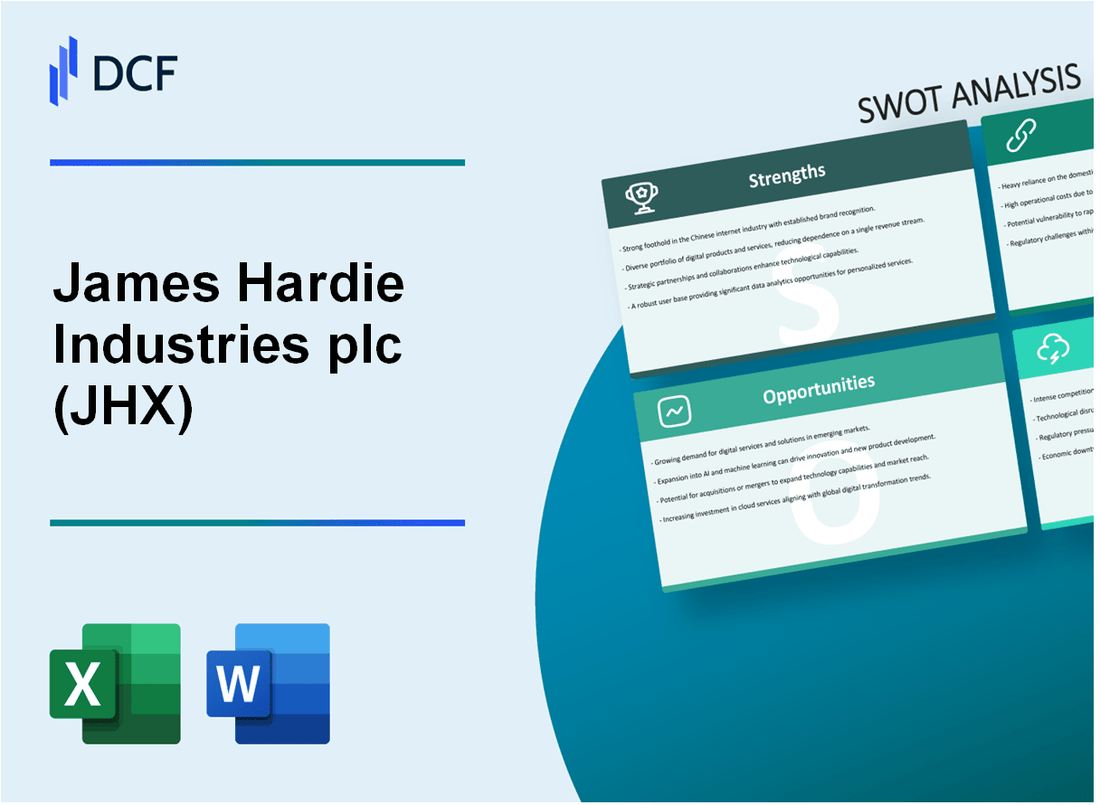
|
James Hardie Industries plc (JHX): SWOT Analysis [Nov-2025 Updated] |

Fully Editable: Tailor To Your Needs In Excel Or Sheets
Professional Design: Trusted, Industry-Standard Templates
Investor-Approved Valuation Models
MAC/PC Compatible, Fully Unlocked
No Expertise Is Needed; Easy To Follow
James Hardie Industries plc (JHX) Bundle
You're looking for a clear-eyed view of James Hardie Industries plc (JHX), and honestly, the picture is one of dominant market position but persistent structural risk. The core takeaway is this: JHX's pricing power in North America is a massive strength, but the shadow of the Asbestos Injuries Compensation Fund (AICF) and cyclical housing market still demand careful risk management. As a seasoned analyst, I see their near-term success tied defintely to the US housing repair and remodel cycle, which is holding up better than new construction. This is the engine, but the fuel-housing starts-is volatile.
James Hardie Industries plc (JHX) - SWOT Analysis: Strengths
North American Market Dominance in Fiber Cement
You are looking at a company that is defintely the 800-pound gorilla in its core market. James Hardie Industries plc has secured an estimated 90% market share in the North American fiber cement category. This isn't just a leading position; it's a near-monopoly in a high-growth building material segment. This dominance is critical because North America is the powerhouse, contributing approximately 80% of the group's operating income.
This market control gives James Hardie a massive structural advantage. It means they dictate the terms of engagement for competitors and have a clear, established distribution channel. The sheer volume of their operations allows them to achieve economies of scale (cost advantages from size) that others simply cannot match.
Superior Brand Recognition and Pricing Power
The Hardie brand is synonymous with premium, low-maintenance exterior siding in the US. This strong brand equity translates directly into pricing power, a key indicator of a healthy business model. For example, in the first quarter of Fiscal Year 2025 (Q1 FY25), the North America Fiber Cement segment saw net sales increase by +5% to $729 million, primarily driven by a higher average net sales price.
This ability to raise prices, even amidst a challenging market environment, shows that customers-from builders to homeowners-are willing to pay a premium for the quality and durability of Hardie products. They are not selling a commodity; they are selling a solution, often showcased by innovative, high-value offerings like the pre-finished ColorPlus line.
Strong Operating Leverage, Driving High Margins
One of the most compelling strengths is the company's exceptional profitability, which comes from its operating leverage (the high proportion of fixed costs means more of each new sales dollar drops to the bottom line). The North American business consistently delivers industry-leading margins.
Here's the quick math for Fiscal Year 2025 (FY25):
| Metric (FY2025) | Value | Source |
|---|---|---|
| North America Full Year EBIT Margin Guidance | 29% to 31% | |
| North America Q1 FY25 EBIT Margin | 31.2% | |
| North America Full Year Adjusted EBITDA Margin (Approx.) | 35% | |
| Global Full Year Adjusted EBITDA | $1.1 billion |
The full-year EBIT margin guidance of 29% to 31% for North America is a clear demonstration of this strength, consistently running well above the 25% floor set out in the original plan. This profitability underpins the company's robust cash flow and ability to fund growth investments.
'House of Hardie' Strategy Successfully Pushing Higher-Value, Higher-Margin Product Mix
The 'House of Hardie' strategy is the engine driving margin expansion. It's a deliberate shift from simply selling fiber cement boards to providing a full, integrated exterior solution. This strategy focuses on increasing the mix of premium products, which carry higher margins.
The long-term goal for the North America Fiber Cement segment is ambitious but achievable: to expand the Adjusted EBITDA margin by another +500 basis points. This is being achieved by:
- Focusing on high-value products like ColorPlus pre-finished siding.
- Increasing the penetration of trim, soffit, and other accessories.
- Partnering with builders like M/I Homes, Inc. for exclusive supply agreements.
This is a smart move. It increases the average net sales price per home and locks in customers with a complete, integrated system, making it harder for rivals to compete on a piece-by-piece basis.
Efficient, Low-Cost Manufacturing Base with Vertically Integrated Supply Chain
The operational backbone of James Hardie is its efficient, low-cost manufacturing network, managed through the Hardie Operating System (HOS). This system is a culture of continuous improvement that drives cost savings and efficiency, helping to offset raw material inflation and other headwinds.
A key indicator of efficiency is the North American effective capacity utilization, which averaged 79% during fiscal year 2025. Furthermore, the company is building a more circular supply chain, which is both sustainable and cost-effective. In FY25, these efforts in North America diverted over 11 percent of manufacturing waste from local landfills, demonstrating a commitment to both operational excellence and environmental stewardship. The operational discipline is real; it's why they can maintain those high margins even when volumes dip.
James Hardie Industries plc (JHX) - SWOT Analysis: Weaknesses
Significant, long-term financial commitment to the Asbestos Injuries Compensation Fund (AICF).
The most persistent and non-negotiable weakness for James Hardie Industries is the ongoing financial liability tied to the Asbestos Injuries Compensation Fund (AICF). This isn't a one-time charge; it's a long-term, structural drain on cash flow that reduces capital available for growth initiatives or shareholder returns, like dividends or buybacks. In the fiscal year 2025 (FY25), the company paid $114 million in asbestos claims and handling costs.
The commitment continues to be a substantial forward-looking obligation. For the fiscal year 2026 (FY26), the company is scheduled to contribute A$153.3 million to the AICF. This liability introduces a layer of financial uncertainty, as the required contributions are subject to actuarial review and currency exchange rate fluctuations, specifically the Australian dollar (A$) versus the US dollar (US$).
Here's the quick math on the recent cash outflow:
- FY25 Total Asbestos Claims and Handling Costs Paid: $114 million
- FY26 Scheduled AICF Contribution: A$153.3 million
- First Half FY26 Asbestos Claims and Handling Costs Paid: $61 million
High sensitivity to the cyclical nature of the US residential construction and repair/remodel markets.
The company is fundamentally a building products supplier, so its performance is tightly linked to the health of the US housing market-specifically new construction and the repair and remodel (R&R) segment. When interest rates rise, mortgage affordability drops, and consumers pull back on large home improvement projects, James Hardie feels the pinch directly. This is a classic cyclical risk.
For example, in fiscal year 2025, the company's overall volumes declined by 3% due to continued market weakness, with the multi-family sector being particularly soft. Even with the strategic acquisition of The AZEK Company Inc. in July 2025, the underlying organic net sales (excluding the acquisition boost) still declined by 1% in the second quarter of FY26, as higher prices were offset by lower volumes in a soft demand environment.
Limited geographic diversity, with the North American market contributing over 80% of net sales.
While the North America Fiber Cement segment is the company's powerhouse-delivering high margins and driving the overall business-this reliance is a concentration risk. If the US housing market experiences a prolonged downturn, there are few other regions large enough to pick up the slack. The company's financial success is disproportionately tied to one economy, which limits its ability to hedge against regional recessions.
To be fair, the North America Fiber Cement segment's earnings before interest and tax (EBIT) margin was in the mid-thirties for FY25, which is exceptional. But still, the revenue breakdown shows where the risk lies. Here's how the net sales broke down in the fiscal year 2025 (FY25):
| Segment | FY25 Net Sales (US$ Millions) | FY25 Contribution to Total Net Sales |
|---|---|---|
| North America Fiber Cement | $2,863.3 | 73.85% |
| Asia Pacific Fiber Cement | $519.9 | 13.41% |
| Europe Building Products | $494.3 | 12.75% |
| Consolidated Total | $3,877.5 | 100.00% |
| Siding Material | Global Market Share (2025 Estimate) | Primary Competitive Advantage |
|---|---|---|
| Vinyl Siding | 38% | Affordability and low maintenance |
| Fiber Cement Siding (JHX Core) | 24% | Durability, fire/pest resistance, aesthetic versatility |
| Composite/Engineered Wood | ~26% (North America Composite) | Appearance of wood with enhanced durability |
The threat is that in a cost-conscious, high-interest-rate environment, builders and homeowners may trade down to less expensive alternatives like vinyl to keep project costs low, directly undercutting James Hardie's market share gains.
Regulatory changes impacting manufacturing or environmental compliance costs.
As a global manufacturer, James Hardie is exposed to evolving and increasingly stringent environmental, social, and governance (ESG) regulations across its operating regions, especially in the US, Europe, and Australia. The company's 2025 annual report explicitly states that future environmental compliance costs will depend on regulatory developments that cannot be predicted.
While the company is proactive, investing in new technology to manage its environmental footprint, these investments are costly. For example, in FY25, James Hardie brought a multi-million-dollar, state-of-the-art water treatment plant online in Carole Park, Australia. They also made a financial investment in a mobile water lab in FY25 to increase water recycling.
The risk is two-fold:
- Uncertain Policy Environment: Potential new tariffs or regulatory changes could increase operational costs quickly.
- Compliance Capital Expenditure: The need to comply with new standards for air emissions, water discharge, or waste management could necessitate unplanned capital expenditures, diverting funds from core growth initiatives.
These compliance costs, though necessary, can erode margins if they outpace the company's ability to drive efficiency through its Hardie Operating System.
Disclaimer
All information, articles, and product details provided on this website are for general informational and educational purposes only. We do not claim any ownership over, nor do we intend to infringe upon, any trademarks, copyrights, logos, brand names, or other intellectual property mentioned or depicted on this site. Such intellectual property remains the property of its respective owners, and any references here are made solely for identification or informational purposes, without implying any affiliation, endorsement, or partnership.
We make no representations or warranties, express or implied, regarding the accuracy, completeness, or suitability of any content or products presented. Nothing on this website should be construed as legal, tax, investment, financial, medical, or other professional advice. In addition, no part of this site—including articles or product references—constitutes a solicitation, recommendation, endorsement, advertisement, or offer to buy or sell any securities, franchises, or other financial instruments, particularly in jurisdictions where such activity would be unlawful.
All content is of a general nature and may not address the specific circumstances of any individual or entity. It is not a substitute for professional advice or services. Any actions you take based on the information provided here are strictly at your own risk. You accept full responsibility for any decisions or outcomes arising from your use of this website and agree to release us from any liability in connection with your use of, or reliance upon, the content or products found herein.
